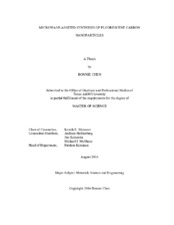| dc.description.abstract | Carbon nanoparticles (CNPs) are a new type of luminescent nanomaterial which have strong potential in biological and biomedical applications, and have been the subject of intense research in recent years. CNPs are nanostructures consisting primarily of carbon atoms and can have tunable optical performance under UV excitation. Moreover, properties including good bio-compatibility, water solubility, and a non-toxic response show that CNPs are safe for the body and the environment. Thus, they are good candidates for both in vivo and in vitro applications. These advantages give CNPs strong potential in term of bio-labeling and bio-imaging.
Although several synthesis routes have been explored, these methods either involve high cost or complex reactions. Here, we explore an innovative and simple microwave-assisted synthesis for the production of CNPs from glucose. This method can control tunable emission and the excitation wavelength of CNPs by manufacturing of output energy during synthesis. Moreover, photoluminescence properties are studied and discussed through emission and absorption spectra. The components, structure, and chemical bonding type are investigated by transmission electron microscopy (TEM) and Raman spectrum.
The results show that CNPs exhibit an amorphous structure with aromatic rings and carbon double bonds and particle size in a nano range which increases with output energy. The emission spectra of CNPs are broad, extending across the visible spectrum, and exhibit a shift with excitation wavelength and output energy. Finally, hypotheses on the fluorescent mechanism and reaction process are proposed which are based on experimental data and literature. The CNPs could be 5-(hydroxymethyl) furfural (5-HMF) derivatives, which are major products of glucose decomposition. | en |


